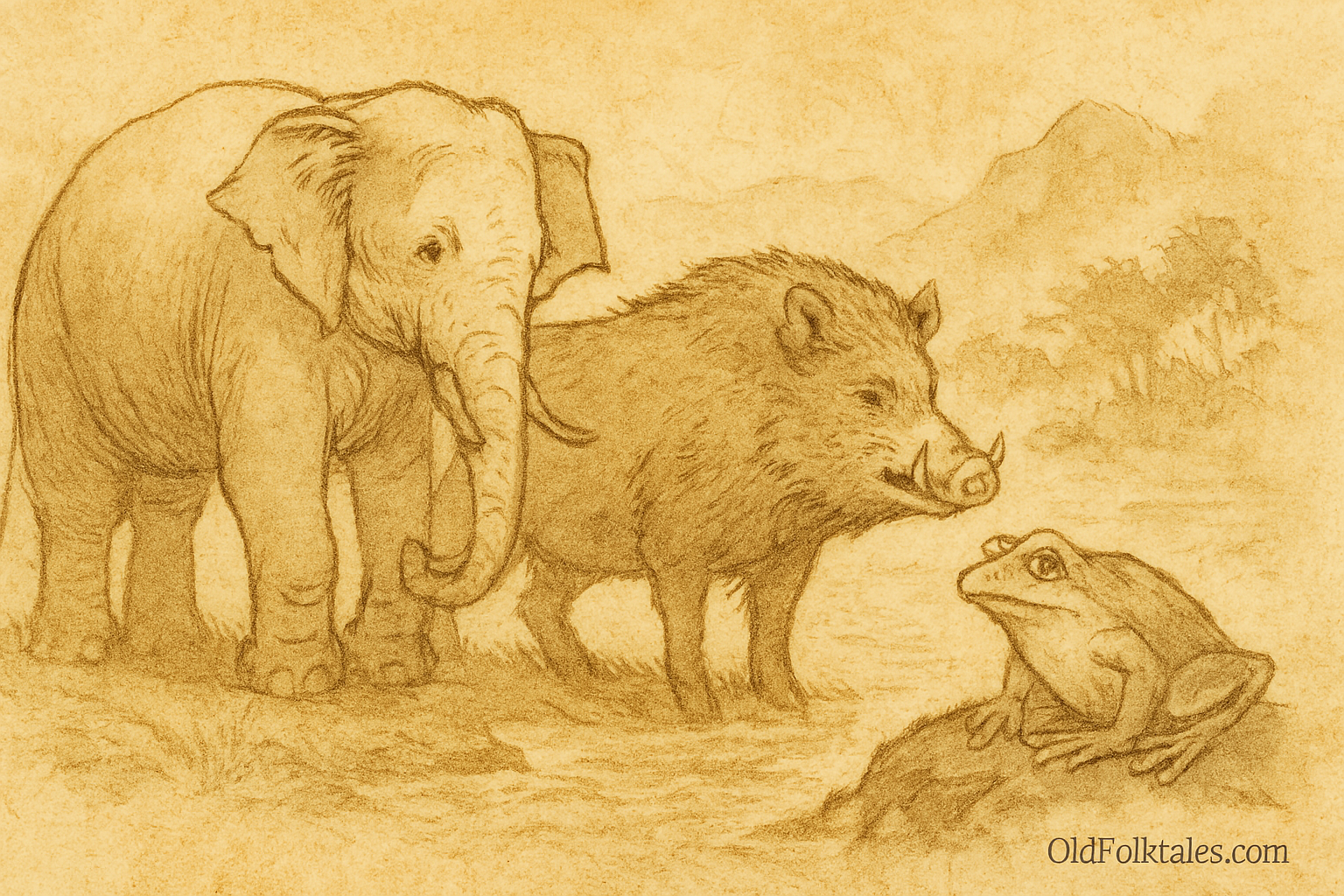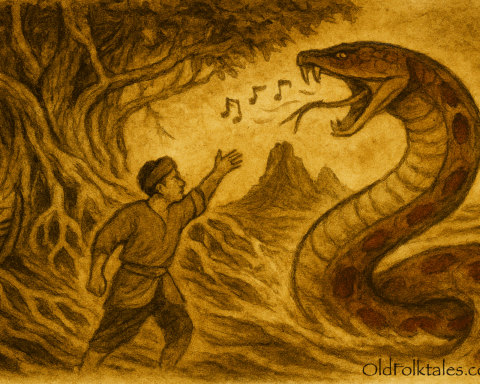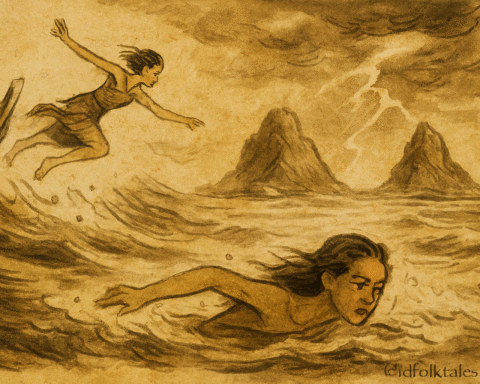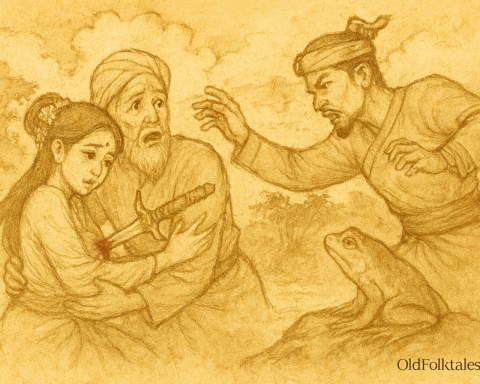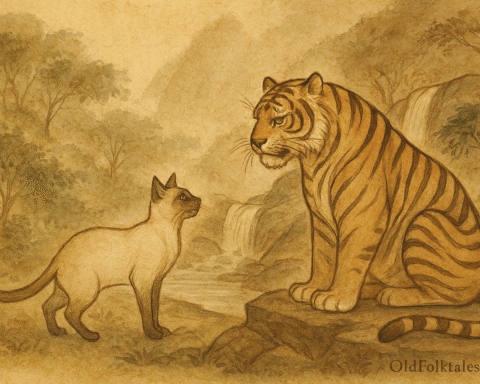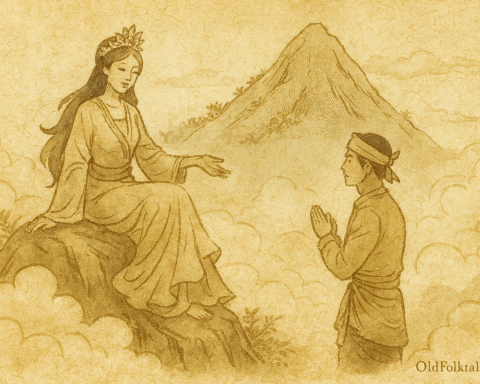Long before the towering buildings of modern Singapore rose against the sky, before the busy port hummed with ships from across the world, the waters between Singapore and Johor were quiet and mysterious. In those ancient times, when the boundary between the mortal and magical realms was thinner than gossamer silk, extraordinary things could happen to ordinary creatures. This is the story of how determination, courage, and perhaps a touch of foolish pride transformed three animals into the islands that still rest in the Johor Straits today.
On the shores of what would one day be called Singapore, three unlikely companions would often gather. There was an elephant, massive and grey, whose footsteps made the earth tremble and whose trumpeting call could be heard across the jungle. His wrinkled skin had weathered countless monsoons, and his tusks gleamed white as bone in the tropical sun. Then there was a pig, stout and determined, with coarse bristles covering his robust body and small, intelligent eyes that saw more than most creatures gave him credit for. And finally, there was a frog, small but spirited, with smooth green skin that glistened with moisture and powerful legs that could launch him great distances with a single leap.
Click to read all Southeast Asian Folktales — featuring legends from Thailand, Indonesia, Vietnam, and the Philippines.
These three would sit together on the rocky shore, gazing across the straits toward the distant coast of Johor. The water between the two lands shimmered under the equatorial sun, sometimes calm as glass, other times churned by sudden tropical storms. The distance seemed both near and impossibly far, depending on the day and the courage of the one doing the looking.
One particularly warm afternoon, as the three friends rested in the shade of coconut palms, their conversation turned to matters of strength and ability. As often happens when pride enters into friendly discussion, what began as casual talk soon became something more serious.
“I could reach those shores,” declared the elephant, his great ears flapping with conviction. “My strength is legendary. My legs are like tree trunks, and I fear nothing.”
“Strength alone is not everything,” countered the pig, pawing at the sand with one trotter. “What matters is determination and clever thinking. I, too, could make that crossing.”
The frog, who had been quietly observing, suddenly spoke up. “You both forget that size is not everything. I have crossed great distances with my leaps. Why should I not be able to reach Johor as well?”
What had started as idle boasting soon transformed into a formal challenge. The three creatures agreed to a contest each would attempt to cross the straits and reach the Johor shore. It would be a test of courage, strength, and will. But as sometimes happens when mortals even animal mortals challenge the natural order of things, the spirits of the waters took notice. A wager, once spoken aloud with such conviction, carries weight in the mystical realms.
A voice like the whisper of waves against stone spoke to them, though none could say from where it came: “So be it. Let each of you attempt this crossing. But know this, those who fail will be transformed into stone, becoming part of these waters forever. Those who succeed will achieve glory beyond measure.”
The three companions looked at one another. Perhaps they should have reconsidered, should have backed down from their boastful claims. But pride is a powerful force, and none wanted to appear cowardly before the others. They agreed to the terms.
The frog, being the smallest and perhaps feeling he had the most to prove, volunteered to go first. At dawn the next morning, he positioned himself at the water’s edge. The elephant and pig watched as their small companion gathered his strength, his legs coiling like springs beneath his compact body. With a mighty leap, the frog launched himself toward the distant shore of Johor.
He sailed through the air in a graceful arc, landing in the water with a splash. He swam with all his might, his powerful legs propelling him forward. But the straits were wider and the currents stronger than they had appeared from shore. The frog fought valiantly against the water, his small body growing weaker with each stroke. Despite his courage and determination, the distance proved too great.
As the wager had decreed, the frog was transformed into stone where he struggled in the water. His body became rock, rising from the waves to form a small island, a permanent testament to his brave attempt. From that day forward, it would be known as Pulau Sekudu, which in the Malay language means Frog Island. Even now, if you look carefully at the shape of the island, some say you can still see the form of the frog forever frozen in his moment of transformation.
Witnessing their companion’s fate should have deterred the elephant and pig from their own attempts. But the sight of the newly formed island only strengthened their resolve. Surely they, being larger and stronger than the frog, would succeed where he had failed.
The elephant went next. With a trumpeting cry that echoed across the water, he waded into the straits. His massive legs churned through the water, creating great splashes with each step. For a time, it seemed he might actually succeed. His size and power carried him far from shore. But even the mighty elephant could not overcome the vast distance and the treacherous currents that swirled through the straits.
The pig, not wanting to see his friend transformed alone, plunged into the water alongside the elephant. Together they struggled, encouraging one another, fighting side by side against the relentless sea. But the water showed no mercy, and the wager was absolute.
As their strength finally gave out, still far from the Johor shore, the ancient magic took hold. Both the elephant and the pig were transformed into stone, their bodies merging together where they had fought side by side. They became a much larger island than the frog had become, a substantial landmass that rose from the waters between Singapore and Johor.
This island, formed from the combined forms of the elephant and pig, became known as Pulau Ubin. The Malay word “ubin” can mean “squared stone” or “granite,” referring to the rocky nature of the island and perhaps to the transformation that created it. Some say that if you explore the island carefully, you can still see in its contours the shapes of the two great creatures who gave their forms to create it, the bulk of the elephant and the determination of the pig, frozen forever in stone.
And so the three islands remain to this day, Pulau Sekudu and Pulau Ubin, silent witnesses to a challenge born of pride and courage, serving as a reminder of what happens when mortals dare to test the boundaries between ambition and ability.
Journey through enchanted forests and islands in our Southeast Asian Folktales collection.
The Moral
This legend teaches us that courage must be balanced with wisdom, and ambition with honest assessment of our capabilities. While it is admirable to strive for greatness and to accept challenges, we must also recognize our limitations and understand that some boundaries exist for good reason. Pride and competitive spirit, when taken too far, can lead to permanent consequences. The three creatures achieved a form of immortality, but not in the way they had hoped transformed not by their success, but by their overreach. True wisdom lies in knowing when to attempt the extraordinary and when to accept the natural order of things.
Knowledge Check
Q1: What three animals attempted to cross the straits in this Singaporean legend?
A: The three animals were an elephant, a pig, and a frog. They were companions who challenged one another to cross from mainland Singapore to the Johor shores, competing to prove their strength, determination, and courage.
Q2: What were the stakes of the challenge between the three creatures?
A: The stakes were extremely high any creature who failed to successfully reach the Johor shore would be transformed into stone. This magical wager was enforced by the spirits of the waters, turning the friendly challenge into a matter of permanent consequence.
Q3: What happened to the frog, and what island did he become?
A: The frog was the first to attempt the crossing. Despite his courage and powerful legs, he could not overcome the distance and strong currents of the straits. He was transformed into stone and became Pulau Sekudu, which literally means “Frog Island” in the Malay language.
Q4: How was Pulau Ubin formed according to this legend?
A: Pulau Ubin was formed when both the elephant and the pig attempted the crossing together. When they failed to reach the Johor shore, they were transformed into stone simultaneously. Their bodies fused together to create the larger island of Pulau Ubin, whose name relates to “squared stone” or “granite” in Malay.
Q5: Why did the three animals accept such a dangerous challenge?
A: The animals were motivated by pride, competitive spirit, and the desire to prove their individual strengths. What began as friendly boasting about their abilities escalated into a formal challenge, and none wanted to appear cowardly by backing down once the wager was proposed.
Q6: What is the cultural significance of this origin story in Singaporean folklore?
A: This legend serves as an origin story explaining the geological formation of real islands in the Johor Straits Pulau Sekudu and Pulau Ubin which still exist today. It reflects the Singaporean and Malay tradition of using storytelling to explain natural landmarks while teaching moral lessons about pride, wisdom, and understanding one’s limitations.
Source:
Traditional Singaporean/Malay legend explaining the origin of Pulau Ubin and Pulau Sekudu
Cultural Origin: Singapore (Malay folklore)
